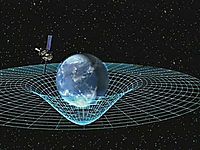
Photo from wikipedia
Space, time and number are key dimensions that underlie how we perceive, identify and act within the environment. They are interconnected in our behaviour and brain. In this study, we… Click to show full abstract
Space, time and number are key dimensions that underlie how we perceive, identify and act within the environment. They are interconnected in our behaviour and brain. In this study, we examined interdependencies between these dimensions. To this end, left- and right-handed participants performed an object collision task that required space-time processing and arithmetic tests that involved number processing. Handedness of the participants influenced collision detection with left-handers being more accurate than right-handers, which is in line with the premise that hand preference guides individual differences as a result of sensorimotor experiences and distinct interhemispheric integration patterns. The data further showed that successful collision detection was a predictor for arithmetic achievement, at least in right-handers. These findings suggest that handedness plays a mediating role in binding information processing across domains, likely due to selective connectivity properties within the sensorimotor system that is guided by hemispheric lateralisation patterns.
Journal Title: Psychological research
Year Published: 2021
Link to full text (if available)
Share on Social Media: Sign Up to like & get
recommendations!